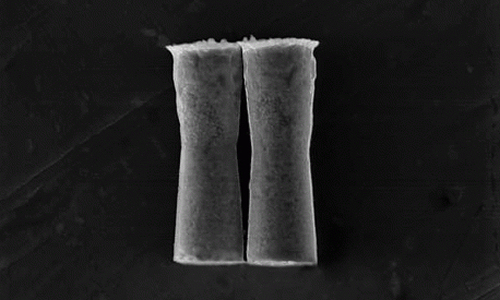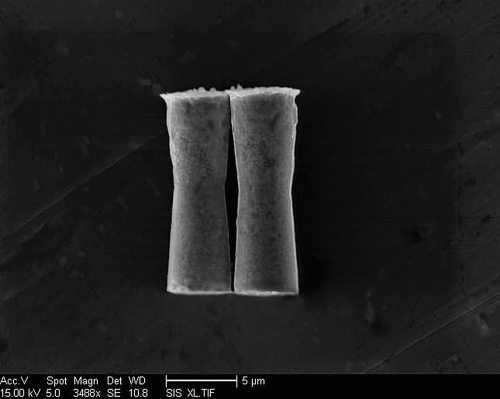Researchers at the University of California, San Diego have shown that a micromotor fueled by stomach acid can take a bubble-powered ride inside a mouse. These tiny motors, each about one-fifth the width of a human hair, may someday offer a safer and more efficient way to deliver drugs or diagnose tumors.
Scanning electron microscopy image of the micromotors. Photo Credit: Jacobs School of Engineering/UC San Diego
The experiment is the first to show that these micromotors can operate safely in a living animal, said Professors Joseph Wang and Liangfang Zhang of the NanoEngineering Department at the UC San Diego Jacobs School of Engineering.
Wang, Zhang and others have experimented with different designs and fuel systems for micromotors that can travel in water, blood and other body fluids in the lab. “But this is the first example of loading and releasing a cargo in vivo,” said Wang. “We thought it was the logical extension of the work we have done, to see if these motors might be able to swim in stomach acid.”
Stomach acid reacts with the zinc body of the motors to generate a stream of hydrogen microbubbles that propel the motors forward. In their study published in the journal ACS Nano, the researchers report that the motors lodged themselves firmly in the stomach lining of mice. As the zinc motors are dissolved by the acid, they disappear within a few days leaving no toxic chemical traces.
When they loaded up the motors with a test “payload” of gold nanoparticles, Wang, Zhang and their coworkers found that more of these particles reached the stomach lining when carried by the motors, compared to when the particles alone were swallowed. The motors delivered 168 nanograms of gold per gram of stomach tissue, compared to the 53.6 nanograms per gram that was delivered through the traditional oral route.
“This initial work verifies that this motor can function in a real animal and is safe to use,” said Zhang.
In the experiment, the mice ingested tiny drops of solution containing hundreds of the micromotors. The motors become active as soon as they hit the stomach acid and zoom toward the stomach lining at a speed of 60 micrometers per second. They can self-propel like this for up to 10 minutes.This propulsive burst improved how well the cone-shaped motors were able to penetrate and stick in the mucous layer covering the stomach wall, explained Zhang. “It’s the motor that can punch into this viscous layer and stay there, which is an advantage over more passive delivery systems,” he said.
The researchers found that nearly four times as many zinc micromotors found their way into the stomach lining compared with platinum-based micromotors, which don’t react with and can’t be fueled by stomach acid.
Wang said it may be possible to add navigation capabilities and other functions to the motors, to increase their targeting potential. Now that his team has demonstrated that the motors work in living animals, he noted, similar nanomachines soon may find a variety of applications including drug delivery, diagnostics, nanosurgery and biopsies of hard-to-reach tumors.
Story Source:
The above story is based on materials provided by the University of California, San Diego.






